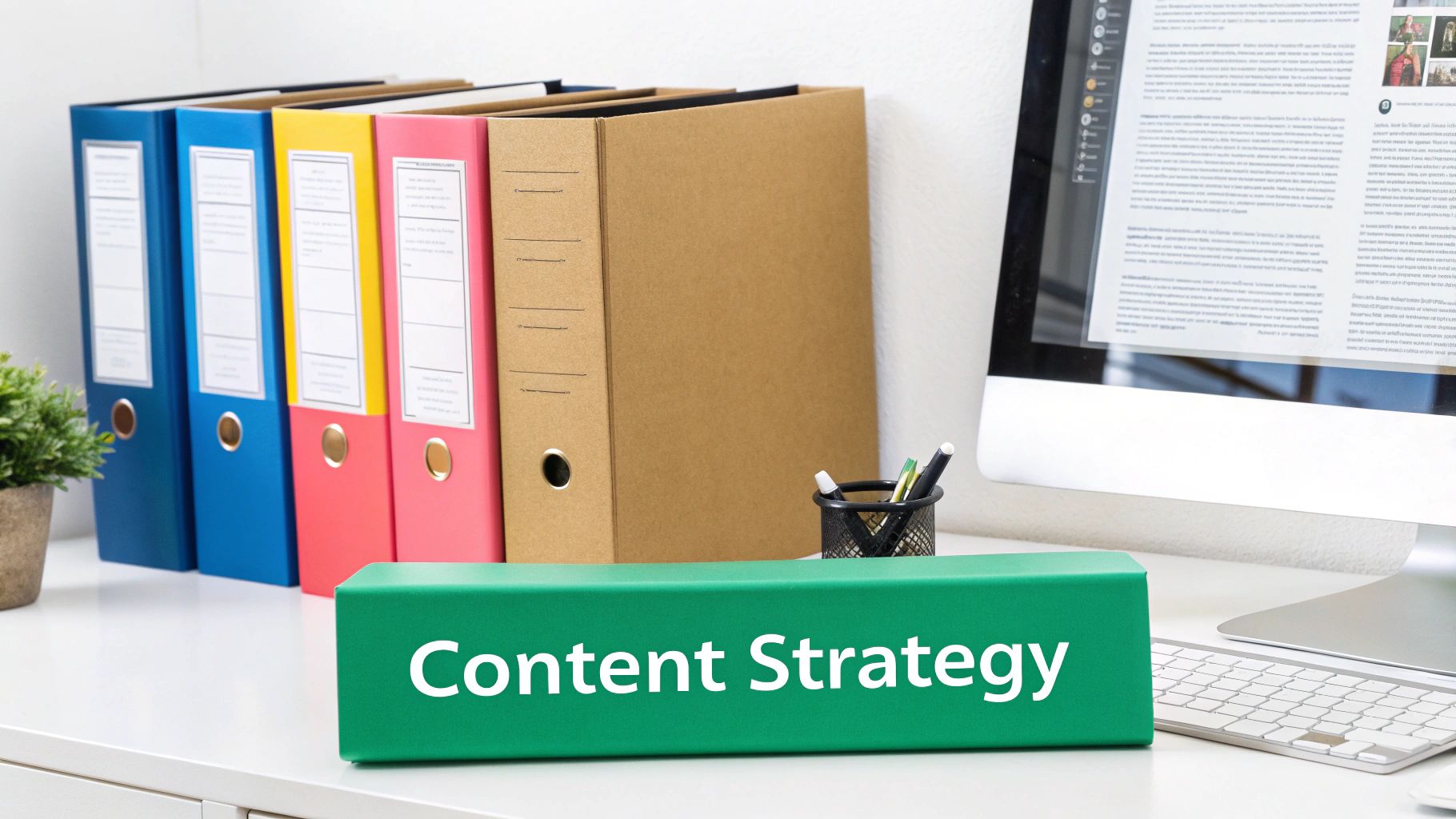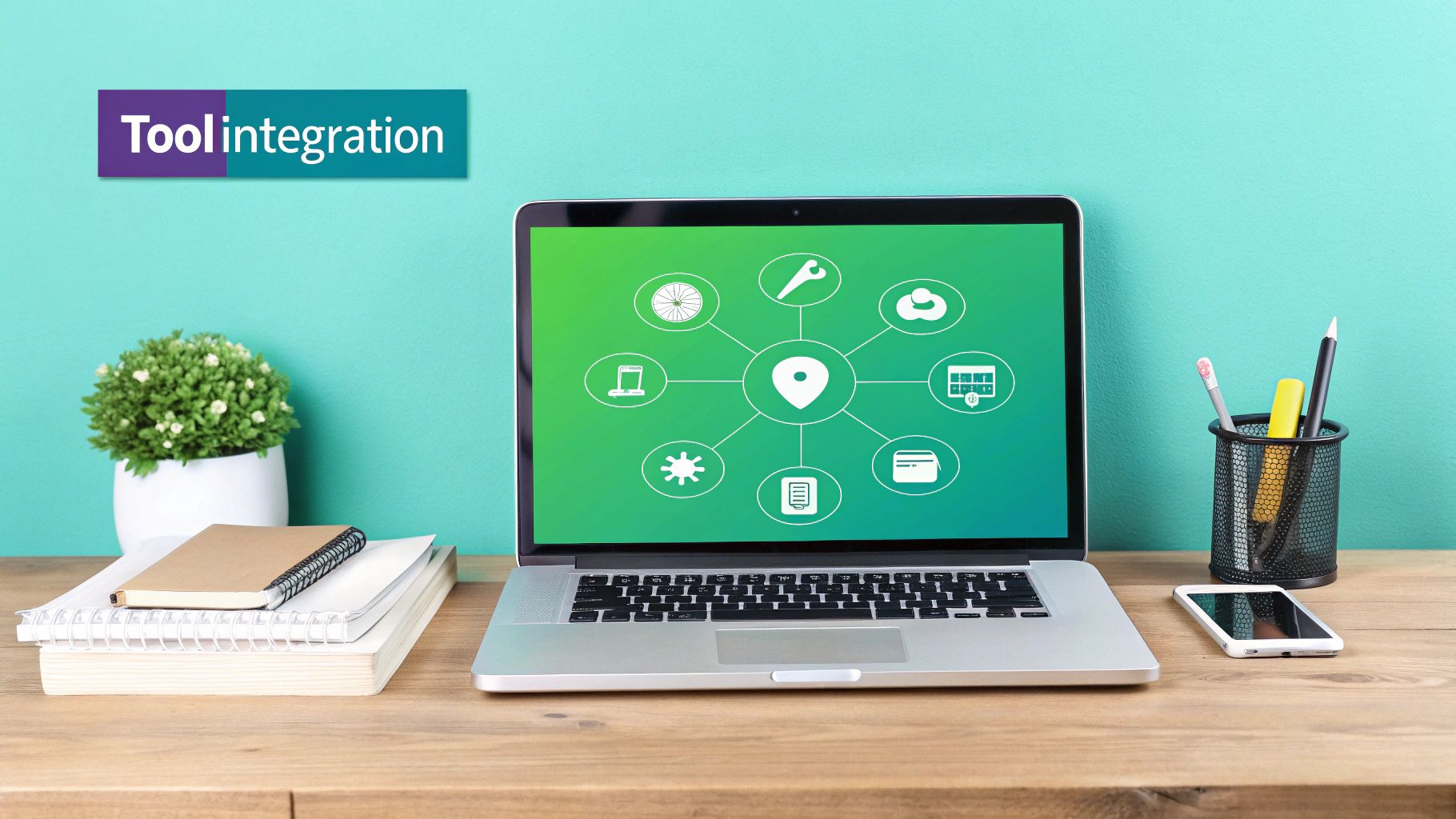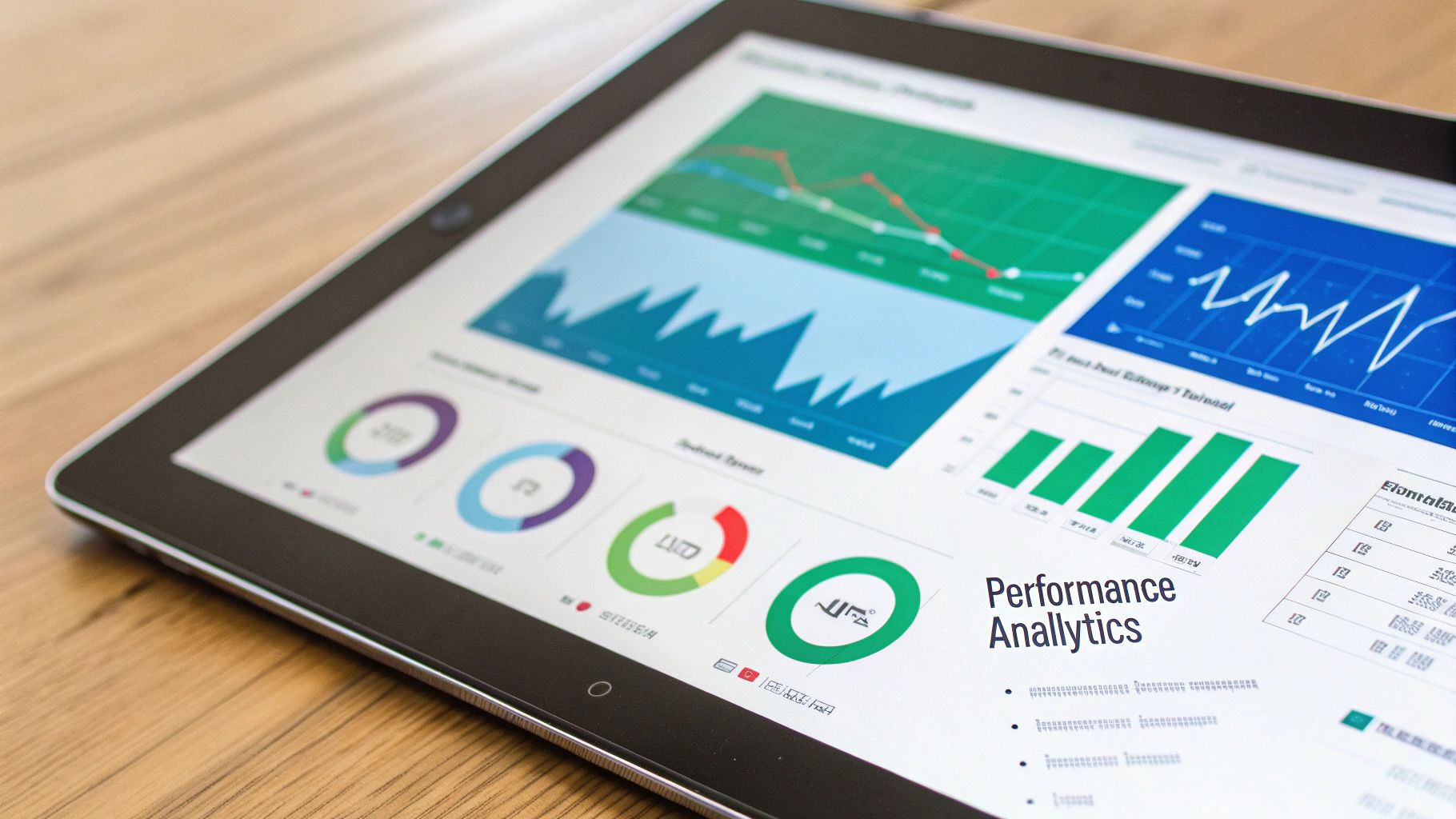9 Sales Enablement Best Practices for GTM Teams in 2025
In today's competitive market, sales enablement has evolved from a simple support function into the strategic engine driving Go-to-Market success. It’s the critical link that empowers sales teams with the right content, tools, training, and analytics to engage buyers effectively and close deals faster. However, many organizations struggle to move beyond generic advice, leaving significant revenue on the table.
This guide cuts through the noise. We'll explore nine proven sales enablement best practices that provide a concrete blueprint for building a high-performing sales organization. These aren't abstract theories; they are actionable strategies designed for immediate implementation. You will learn how to equip your sellers with precisely what they need, exactly when they need it, to have more meaningful and successful conversations with prospects.
From fostering true sales and marketing alignment to creating a dynamic content management system, each point is a critical component of a cohesive and powerful enablement framework. We will also show how integrating tools like Intently can help you monitor online sentiment and uncover high-intent leads, giving your team a crucial competitive edge. This listicle is designed for solopreneurs, marketing teams, and sales organizations ready to transform their outreach, boost efficiency, and create a scalable system for predictable growth. Let's dive into the blueprint.
1. Sales and Marketing Alignment
One of the most foundational sales enablement best practices is the strategic alignment of your sales and marketing teams, often called "smarketing." This practice involves creating unified goals, processes, and communication channels to ensure a consistent customer experience from the first touchpoint to the final sale. When marketing understands what a high-quality lead looks like to sales, and sales knows how to leverage the content marketing creates, the entire revenue engine runs more efficiently.

This alignment is critical because it eliminates the common friction point where marketing passes over unqualified leads or sales fails to follow up effectively. By establishing shared definitions for terms like Marketing Qualified Lead (MQL) and Sales Qualified Lead (SQL), both teams operate from the same playbook. The result is a seamless handoff process, higher conversion rates, and a significant boost in ROI. For instance, Adobe improved its B2B sales performance by 30% after implementing shared Service Level Agreements (SLAs) between their teams.
How to Implement Sales and Marketing Alignment
Successfully aligning these two departments requires deliberate effort and structured processes. It's more than just encouraging teams to talk; it’s about integrating their core functions.
- Establish a Service Level Agreement (SLA): Create a formal document that outlines the commitments each team makes to the other. Marketing might commit to delivering a specific number of MQLs per month, while sales commits to following up with those leads within a set timeframe.
- Hold Regular 'Smarketing' Meetings: Schedule weekly or bi-weekly meetings for both teams to review metrics, discuss campaign performance, share feedback on lead quality, and plan future initiatives. This keeps communication open and proactive.
- Create a Unified Content Strategy: Involve sales in the content creation process. Their firsthand knowledge of customer pain points and common questions is invaluable for creating collateral that resonates and helps close deals.
- Utilize a Shared CRM: Centralize all customer data in a CRM that both teams can access. This provides a single source of truth for tracking a lead’s journey and measuring the impact of alignment efforts. This data-driven approach is essential for demonstrating the value of your sales enablement best practices.
2. Comprehensive Content Strategy and Management
A cornerstone of effective sales enablement is a comprehensive content strategy that equips your sales team with the right information at the right time. This practice involves developing, organizing, and distributing relevant, personalized assets that support sales conversations at every stage of the buyer's journey. Instead of creating content in a vacuum, this approach ensures every case study, whitepaper, and one-pager is purpose-built to address specific customer pain points and objections.

The impact of a well-managed content library is immense. When reps can easily find and share effective content, they spend less time searching for materials and more time selling. This is one of the sales enablement best practices that directly boosts productivity and buyer confidence. For example, IBM developed an industry-specific content strategy that armed reps with tailored materials, resulting in an 18% improvement in win rates. The goal is to transform content from a static resource into a dynamic sales tool.
How to Implement a Comprehensive Content Strategy
Building a powerful content engine requires more than just writing blog posts; it demands a systematic approach to creation, organization, and distribution.
- Map Content to the Buyer's Journey: Begin by defining your buyer personas and mapping out their journey from awareness to decision. Create specific content pieces designed to answer questions and overcome challenges at each stage.
- Conduct Regular Content Audits: Perform a quarterly audit of your existing content to identify top-performing assets, find gaps, and retire outdated materials. Use a content scorecard to track performance metrics like usage rates and influence on deals.
- Implement a Centralized Management System: Use a sales enablement platform like Seismic or Highspot to create a single source of truth for all sales content. Implement a robust tagging and categorization system so reps can quickly find content by industry, persona, stage, or product.
- Use Sales Feedback to Guide Creation: Create a formal feedback loop where the sales team can share insights from the field. Their direct knowledge of customer conversations is crucial for prioritizing and creating content that truly resonates and helps close deals.
3. Technology Stack Integration and Optimization
A cornerstone of modern sales enablement best practices is the strategic integration and optimization of your technology stack. This involves carefully selecting and connecting your CRM, sales engagement platforms, and other tools to create a seamless, unified workflow. When systems communicate effectively, data flows freely, eliminating manual entry, reducing administrative burden, and empowering reps with a complete view of the customer journey.

The goal is to build an ecosystem where each tool enhances the others, rather than creating isolated data silos. For example, integrating a tool like LinkedIn Sales Navigator with your CRM allows reps to access valuable prospect insights without switching tabs, streamlining research and outreach. This level of integration transforms individual tools into a powerful, cohesive system that drives productivity and provides actionable, data-driven insights for continuous improvement.
How to Implement Technology Stack Integration
Building an optimized tech stack requires a strategic approach that prioritizes workflow efficiency and user adoption over simply acquiring the latest tools.
- Conduct a Thorough Needs Assessment: Before investing in new software, map out your current sales process and identify specific bottlenecks. Involve your sales team to understand their daily challenges and where technology could have the most impact.
- Prioritize Integration Capabilities: When evaluating new tools, make their ability to integrate with your existing core systems (like your CRM) a primary criterion. Look for native integrations or robust API support to ensure smooth data flow.
- Provide Comprehensive Training: A tool is only effective if your team knows how to use it. Go beyond basic feature training and focus on teaching integrated workflows. Show reps how the connected systems work together to make their jobs easier.
- Regularly Audit and Optimize: Your technology needs will evolve. Schedule quarterly or semi-annual audits to assess tool usage, gather feedback from your team, and measure ROI. Don't be afraid to retire underutilized or redundant software. You can learn more about how specific technologies fit into this strategy with this complete guide to AI lead generation tools.
4. Data-Driven Performance Analytics and Insights
One of the most powerful sales enablement best practices is leveraging data-driven analytics to guide strategy and optimize performance. This involves moving beyond gut feelings and using concrete sales data, metrics, and analytics to identify trends, pinpoint areas for improvement, and make informed decisions. By tracking key performance indicators (KPIs) and conducting deep-dive analyses, organizations can understand what truly drives success.

This data-centric approach is crucial for validating the impact of your sales enablement initiatives. Instead of guessing if a new training program or content piece is effective, you can measure its direct influence on metrics like win rates, sales cycle length, and deal size. Platforms like Gong.io offer conversation intelligence that helps companies like Shopify analyze sales calls to replicate winning behaviors, demonstrating how analytics can turn raw data into a competitive advantage and a cornerstone of modern sales enablement best practices.
How to Implement Data-Driven Performance Analytics
Building a data-driven culture requires more than just buying software; it demands a strategic approach to collecting, interpreting, and acting on information.
- Start with a Core Set of Meaningful Metrics: Avoid "analysis paralysis" by focusing on KPIs that directly align with your business goals. Key metrics often include conversion rates by stage, average deal size, sales cycle duration, and quota attainment.
- Ensure Data Quality and Consistency: Your insights are only as good as your data. Establish clear processes for data entry and management within your CRM to ensure all information is accurate, complete, and uniformly formatted.
- Create Actionable Insights, Not Just Reports: Use visualization tools like Tableau or Microsoft Power BI to create dashboards that don't just display data but tell a story. The goal is to highlight trends and provide clear, actionable next steps for sales reps and leaders.
- Train Teams on Data Interpretation and Usage: Equip your sales team with the skills to understand their performance data. Regular training sessions on how to read dashboards and use insights to self-correct and improve their approach are essential for adoption.
5. Ongoing Training and Skill Development Programs
A static sales team is an ineffective one. One of the most critical sales enablement best practices is implementing continuous training and skill development programs. This goes beyond a simple onboarding process and establishes a culture of perpetual learning, ensuring your team is equipped to handle evolving market dynamics, new product features, and sophisticated buyer expectations. When reps are continuously sharpening their skills, they are more confident, adaptable, and effective in their roles.
This commitment to ongoing education is what separates top-performing organizations from the rest. It addresses the natural erosion of skills and knowledge over time, keeping the entire team aligned with the latest sales methodologies and industry trends. Companies like SAP have demonstrated immense success with comprehensive sales academies that provide structured learning paths. This consistent reinforcement builds mastery, boosts morale, and directly impacts revenue by enabling sellers to navigate complex deals with greater expertise.
How to Implement Ongoing Training and Development
Effective training is not a one-time event but a continuous, integrated process. It requires a strategic approach that blends different learning formats and methodologies to keep sellers engaged and proficient.
- Utilize Microlearning and Spaced Repetition: Break down complex topics into short, digestible modules (microlearning) that can be consumed on the go. Reinforce this knowledge at strategic intervals (spaced repetition) to improve long-term retention and application.
- Incorporate Real-World Scenarios: Move beyond theoretical concepts by using role-playing, real-life case studies, and call recordings in your training. This allows reps to practice their skills in a safe environment and learn from tangible examples.
- Provide Diverse Learning Formats: Cater to different learning styles by offering a mix of content formats, including video tutorials, interactive workshops, podcasts, written guides, and peer-to-peer coaching sessions.
- Establish Mentorship Programs: Pair newer or developing reps with seasoned top performers. A structured mentorship or buddy program provides personalized guidance, accelerates skill acquisition, and strengthens team cohesion. This is a powerful, yet low-cost, sales enablement best practice.
6. Sales Coaching and Mentorship Excellence
Effective sales enablement best practices extend beyond content and technology; they involve directly investing in your people. Sales coaching and mentorship excellence is the practice of establishing systematic programs where experienced leaders provide ongoing guidance, feedback, and skill development to improve individual and team performance. Instead of ad-hoc advice, this approach formalizes coaching with regular one-on-one sessions, structured deal reviews, and targeted skill-building exercises.
This structured approach is critical for developing a high-performing sales culture and retaining top talent. It transforms managers from simple supervisors into true performance multipliers who can diagnose skill gaps and build confidence in their teams. For example, Xerox implemented a systematic coaching framework that improved sales performance by a staggering 25%. Similarly, Microsoft's manager-as-coach training program equips leaders with the tools needed to guide reps effectively, fostering continuous improvement rather than just hitting a quota.
How to Implement Sales Coaching and Mentorship Excellence
Building a world-class coaching program requires a clear structure, consistent execution, and dedicated resources. It’s about creating a developmental culture, not just a series of meetings.
- Train Managers in Effective Coaching: Don't assume managers instinctively know how to coach. Invest in training that teaches them proven methodologies like the GROW model or Salesforce's V2MOM framework to guide productive, goal-oriented conversations.
- Use Data to Identify Coaching Opportunities: Leverage your CRM and sales analytics to pinpoint specific areas where reps are struggling, such as low discovery-to-demo conversion rates or difficulty overcoming certain objections. This allows for targeted, impactful coaching.
- Create Coaching Templates and Guides: Equip managers with conversation guides, deal review templates, and skill assessment scorecards. This standardizes the process, ensuring every rep receives a consistent and high-quality coaching experience.
- Document Coaching Activities and Outcomes: Track coaching sessions, agreed-upon action items, and progress over time within your CRM or a sales enablement platform. This documentation is essential for measuring the impact of your coaching efforts and holding both reps and managers accountable.
7. Customer Journey Mapping and Personalization
A critical component of modern sales enablement best practices is understanding and acting on the customer's buying journey. This involves creating detailed maps of the entire process a prospect goes through, from initial awareness to the final purchase decision. By mapping this journey, you can personalize sales content, outreach, and interactions based on where a prospect is, what they need, and what their primary pain points are at that specific stage.
This approach moves sales from a one-size-fits-all model to a highly tailored, consultative process. When reps understand the customer's mindset at each touchpoint, they can deliver the right message at the right time, building trust and demonstrating value more effectively. For example, Salesforce’s customer-centric model is built on this principle, using journey maps to ensure every interaction is relevant and helpful. The result is a more seamless customer experience, shorter sales cycles, and improved lead conversion rates.
How to Implement Customer Journey Mapping and Personalization
Developing and activating customer journey maps requires a deep dive into your buyer's world and a commitment to data-driven personalization. This is about seeing the sales process through their eyes.
- Conduct Customer Interviews and Surveys: The best data comes directly from the source. Regularly talk to new customers, long-term clients, and even lost prospects to understand their decision-making process, challenges, and what they valued during their journey.
- Use CRM Data to Validate Assumptions: Your CRM is a goldmine of behavioral data. Analyze deal stages, interaction history, and content engagement to identify patterns and validate the qualitative insights you gathered from interviews. This helps you build data-backed journey maps.
- Create Maps for Different Buyer Personas: Not all customers are the same. Develop distinct journey maps for each of your key buyer personas to account for their unique needs, goals, and communication preferences throughout the buying process.
- Train Sales Teams on Journey-Based Selling: Equip your reps with the knowledge to identify a prospect's stage in the journey and provide them with playbooks and content tailored to that stage. For more foundational knowledge, you can learn more about B2B lead generation to better inform your journey maps.
8. Cross-Functional Collaboration and Communication
Beyond "smarketing," one of the most impactful sales enablement best practices is fostering systematic collaboration across all customer-facing and product-related departments. This involves breaking down silos between sales, customer success, product development, and operations to create a unified front. When teams share insights and are aligned on goals, the customer receives a consistent, high-quality experience throughout their entire lifecycle, not just during the sales process.
True cross-functional alignment ensures that feedback from the front lines directly informs product improvements and that customer success is prepared for the promises made during the sale. This holistic approach prevents common issues like product-market disconnects or poor customer onboarding. For example, Atlassian's famous cross-functional team structure ensures that engineering, marketing, and support all contribute to a shared vision, which is a key driver of its product-led growth model. This level of integration transforms the organization from a collection of departments into a single revenue-focused team.
How to Implement Cross-Functional Collaboration
Building a collaborative culture requires more than just shared goals; it demands structured processes and transparent communication channels that connect disparate teams.
- Establish Shared Success Metrics: Move beyond department-specific KPIs. Implement shared metrics like Customer Lifetime Value (CLV) or Net Revenue Retention (NRR) that require input and effort from sales, product, and customer success teams to succeed.
- Create Cross-Functional Pods or Squads: Organize teams around specific customer segments, products, or strategic initiatives. These small, autonomous groups should include members from sales, marketing, product, and support to tackle challenges holistically.
- Utilize a Centralized Collaboration Platform: Use tools like Slack, Asana, or a shared CRM to create transparent communication channels. This ensures everyone has visibility into customer feedback, product updates, and sales pipeline progress. It's also vital for effective social media reputation monitoring where insights must be shared quickly across teams.
- Document and Share Best Practices: Create an internal knowledge base or wiki where teams can document processes, share successful strategies, and access customer insights. This prevents knowledge from being siloed and empowers every employee with critical information.
9. Continuous Process Improvement and Optimization
Effective sales enablement is not a one-time project; it's an ongoing commitment to refinement. Continuous process improvement involves systematically reviewing, analyzing, and optimizing your sales workflows, content, and strategies based on performance data and feedback. This practice, rooted in methodologies like Toyota's Kaizen, ensures your sales function remains agile and effective in a constantly changing market.
Adopting this mindset means you are always searching for small, incremental gains that compound over time. Instead of waiting for a process to break, you proactively identify bottlenecks, inefficiencies, and opportunities for enhancement. For example, General Electric famously applied Six Sigma principles to its sales operations to reduce errors in order processing and improve forecast accuracy, leading to significant revenue gains. This dedication to iterative improvement is a hallmark of high-performing sales organizations.
How to Implement Continuous Process Improvement
Integrating continuous improvement requires a cultural shift towards data-driven decision-making and a willingness to challenge the status quo. It’s about building a system where optimization is a regular, expected activity.
- Establish Key Performance Indicators (KPIs): Define clear, measurable metrics for every stage of your sales process, such as lead response time, conversion rates, and sales cycle length. These KPIs will be the foundation for identifying areas that need improvement.
- Implement Feedback Loops: Create formal channels for frontline sales reps to share insights and suggest improvements. Their direct experience with customers and internal processes is invaluable for spotting friction points that data alone might miss.
- Use Process Mapping: Visually map your current sales processes to identify redundancies, delays, and non-value-added steps. Tools like Lucidchart or Miro can help you visualize workflows and pinpoint opportunities for streamlining.
- Conduct Regular Review Cycles: Schedule monthly or quarterly reviews to analyze performance against KPIs, discuss feedback from the team, and prioritize improvement initiatives. This iterative approach is a core component of successful sales enablement best practices.
Sales Enablement Best Practices Comparison
| Item | Implementation Complexity 🔄 | Resource Requirements ⚡ | Expected Outcomes 📊 | Ideal Use Cases 💡 | Key Advantages ⭐ |
|---|---|---|---|---|---|
| Sales and Marketing Alignment | Medium to High - requires organizational change and ongoing maintenance | Medium - cross-team collaboration tools and time | Improved lead quality, shorter sales cycles, revenue growth | Organizations seeking unified messaging and goal alignment | Enhanced collaboration and consistent customer experience |
| Comprehensive Content Strategy and Management | High - significant content creation and maintenance effort | High - content development, management systems | Accelerated deal progression, improved sales effectiveness | Sales teams needing targeted, persona-based content support | Consistent messaging, data-driven optimization |
| Technology Stack Integration and Optimization | High - complex integrations and ongoing IT support required | High - tools, platform licenses, integration efforts | Increased sales productivity, data accuracy, better analytics | Companies leveraging multiple sales and enablement tools | Streamlined workflows, better reporting, higher adoption |
| Data-Driven Performance Analytics and Insights | Medium - requires solid data infrastructure and literacy | Medium - analytics platforms and training | Data-driven decisions, clear ROI measurement, process optimization | Teams focusing on performance measurement and forecasting | Actionable insights, strategic planning |
| Ongoing Training and Skill Development Programs | Medium to High - continuous content development and training delivery | Medium to High - training materials, modules, time investment | Improved performance, faster onboarding, higher engagement | Organizations emphasizing skill growth and certification | Higher retention, better market adaptation |
| Sales Coaching and Mentorship Excellence | Medium - structured coaching frameworks and manager time | Medium - coaching training and scheduling | Personalized skill development, faster performance gains | Teams needing individualized support and deal improvement | Higher close rates, knowledge transfer |
| Customer Journey Mapping and Personalization | High - requires deep research, data collection, and content personalization | Medium to High - persona research and CRM data usage | Higher engagement, conversion rates, and customer satisfaction | Businesses focused on tailored buyer experiences | Competitive differentiation and relevant messaging |
| Cross-Functional Collaboration and Communication | Medium to High - coordinating multiple departments and communication flows | Medium - tools and time for collaboration | Improved customer experience consistency, reduced friction | Organizations aiming for holistic customer success efforts | Improved insights, organizational agility |
| Continuous Process Improvement and Optimization | Medium - requires dedicated resources and change management | Medium - time and tools for process analysis | Increased efficiency, adaptability, competitive advantage | Companies committed to ongoing sales process excellence | Sustainable productivity gains and data-driven culture |
Activating Your Sales Enablement Strategy for Lasting Growth
The journey to sales excellence is not a destination but a continuous cycle of refinement and adaptation. Throughout this guide, we've explored nine foundational sales enablement best practices that serve as the pillars of a high-performing revenue engine. From forging an unbreakable alliance between sales and marketing to leveraging data for predictive insights, each element is a critical gear in a complex, interconnected machine.
Mastering these strategies is about transforming your organization from a collection of individual contributors into a unified force, all working towards a common goal. It’s about empowering every seller with the right content, tools, and training precisely when they need it most. This holistic approach ensures that your team is not just selling, but solving problems, building relationships, and creating value at every stage of the customer journey.
From Theory to Action: Your Next Steps
The difference between a good sales organization and a great one often comes down to execution. The concepts we've discussed are powerful, but their true value is unlocked only through deliberate action. To move forward, consider this simple, three-step framework:
- Assess and Prioritize: Begin with an honest audit of your current sales enablement maturity. Where are your biggest gaps? Is it a disconnect between sales and marketing? A clunky tech stack? A lack of consistent coaching? Identify the one or two areas that, if improved, would deliver the most significant impact on your revenue goals and start there.
- Implement Iteratively: Avoid the temptation to overhaul everything at once. This often leads to confusion and burnout. Instead, implement changes in focused, iterative sprints. For example, you might spend one quarter optimizing your content management system and the next launching a formal sales coaching program. Small, consistent wins build momentum and create lasting change.
- Measure and Refine: Embed a culture of continuous improvement by tracking key performance indicators for every initiative. Are your new training modules improving quota attainment? Is your new content strategy shortening the sales cycle? Use this data not to judge, but to learn, adapt, and refine your approach. This commitment to data-driven decision-making is a cornerstone of modern sales enablement best practices.
The True Impact of Strategic Enablement
Ultimately, investing in these sales enablement best practices is an investment in your people and your customers. When sellers feel supported, confident, and equipped for success, they perform at a higher level. They become trusted advisors to your clients, which in turn fosters loyalty and drives long-term growth.
This is not just about hitting quarterly targets; it's about building a resilient, adaptable, and scalable sales ecosystem that can thrive in any market condition. By combining strategic alignment, data-driven insights, continuous learning, and intelligent tools, you are creating a culture of success that becomes your ultimate competitive advantage. You are laying the groundwork for a future where your revenue goals are not just met, but consistently and predictably exceeded.
Ready to fuel your newly enabled sales team with a consistent flow of high-intent prospects? Intently scours social platforms to find buyers actively searching for solutions like yours, delivering warm leads directly to your pipeline. Stop chasing cold leads and start engaging qualified buyers by exploring Intently today.
